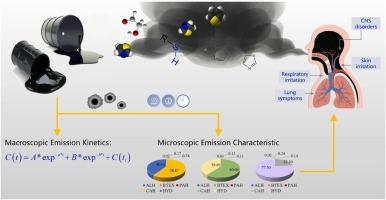Contribution of Rubber Modified Asphalt to Emission and Odors Tracing: Experimental and Modelling Investigation
IF 11.3
1区 环境科学与生态学
Q1 ENGINEERING, ENVIRONMENTAL
引用次数: 0
Abstract
Rubber modified asphalt (RMA) is widely used in infrastructure due to its superior performance; however, its emissions pose environmental and health risks, particularly in enclosed or densely populated areas. This study used emission kinetics, odor assessment, and health risk analysis methods to evaluate the emission characteristics and risks assessment of different types of RMA and its extracted crumb rubber, and reveal the contributions of crumb rubber to RMA emissions. Results revealed that for RMA, macroscopic emission kinetics of H2S and volatile organic compounds (VOCs) emissions from RMA followed a bi-exponential function, with odor primarily driven by cyclic aromatic hydrocarbons and hydrocarbon derivatives, accounting for >99%. Key odorants identified were octanal, benzothiazole, and 4-methyl-dibenzothiophene. 4-methyl-dibenzothiophene has been identified as a key target for controlling odor and health risks throughout the entire RMA lifecycle. Benzothiazole, decanal, and octanal are found to be characteristic odor contributors of crumb rubber to RMA. Odor assessment analysis confirmed crumb rubber was the major VOCs source in early emission stages. This study provides data-driven guidance for tracking odor emission sources, developing low-emission RMA materials, supporting sustainable infrastructure practices, and improving occupational health standards.

橡胶改性沥青对废气排放和气味追踪的贡献:实验和模型研究
橡胶改性沥青(RMA)因其优越的性能被广泛应用于基础设施;然而,其排放构成环境和健康风险,特别是在封闭或人口稠密地区。本研究采用排放动力学、气味评价和健康风险分析等方法,评价了不同类型RMA及其提取胶屑的排放特征和风险评价,揭示了胶屑对RMA排放的贡献。结果表明,RMA中H2S和挥发性有机化合物(VOCs)的宏观排放动力学遵循双指数函数,其中气味主要由环芳烃和烃衍生物驱动,占99%;鉴定出的主要气味剂为辛烷、苯并噻唑和4-甲基二苯并噻吩。4-甲基二苯并噻吩已被确定为在整个RMA生命周期中控制气味和健康风险的关键目标。发现苯并噻唑、癸醛和辛醛是橡胶屑对RMA的特征气味贡献者。气味评价分析证实,橡胶屑是早期挥发性有机化合物的主要来源。该研究为追踪气味排放源、开发低排放RMA材料、支持可持续基础设施实践和提高职业健康标准提供了数据驱动的指导。
本文章由计算机程序翻译,如有差异,请以英文原文为准。
求助全文
约1分钟内获得全文
求助全文
来源期刊

Journal of Hazardous Materials
工程技术-工程:环境
CiteScore
25.40
自引率
5.90%
发文量
3059
审稿时长
58 days
期刊介绍:
The Journal of Hazardous Materials serves as a global platform for promoting cutting-edge research in the field of Environmental Science and Engineering. Our publication features a wide range of articles, including full-length research papers, review articles, and perspectives, with the aim of enhancing our understanding of the dangers and risks associated with various materials concerning public health and the environment. It is important to note that the term "environmental contaminants" refers specifically to substances that pose hazardous effects through contamination, while excluding those that do not have such impacts on the environment or human health. Moreover, we emphasize the distinction between wastes and hazardous materials in order to provide further clarity on the scope of the journal. We have a keen interest in exploring specific compounds and microbial agents that have adverse effects on the environment.
 求助内容:
求助内容: 应助结果提醒方式:
应助结果提醒方式:


